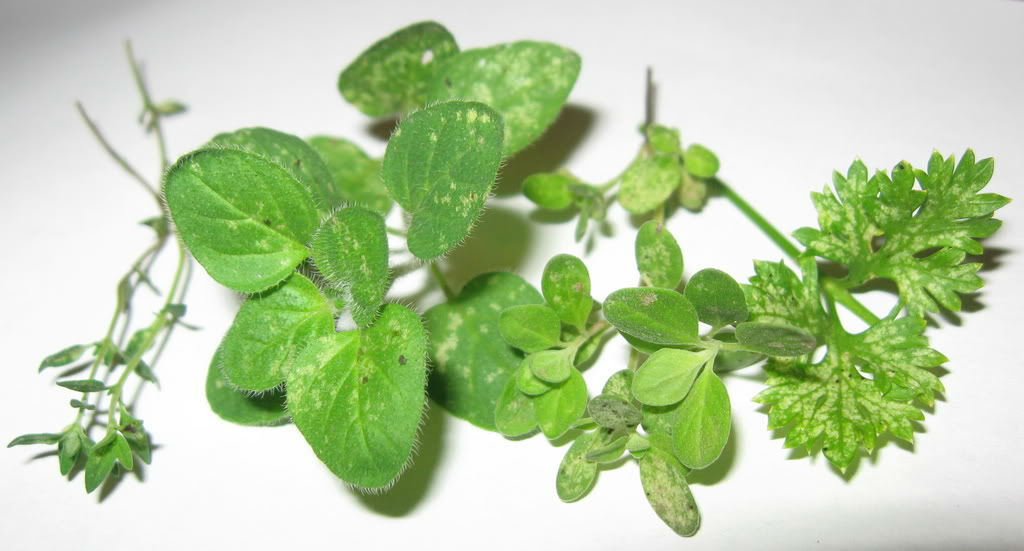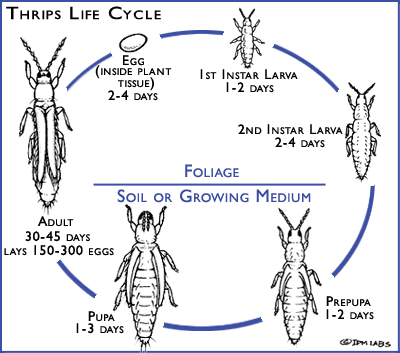A question came in this week to Ask Gardenerd that I have been asking myself for awhile, but never felt compelled to research the answer. Now I have no excuse:
“Hello! The leaves of many of my herbs have white speckles on them
lately. (It almost looks like they’re variegated). It’s definitely not
on the leaves, but more so ‘in’ the leaves and is appearing on many of
the varieties, such as thyme, basil, and cilantro. Any ideas on what
might be the cause? Many thanks!!” 
I’ve seen this in my own garden – and this web forum not only has a great picture of the damage to several different types of herbs, but also offers a possible cause and solution:
White Spots on Herbs – take note of the homemade spray recipe listed in the forum.
It’s possible that you have either leafhoppers or thrips.
Leafhoppers

Various Leafhoppers. Photo courtesy of Illinois Natural History Research
Leafhoppers come in many shapes and colors, but they are usually small and deftly jump off your plants just when you think you might be able to catch them. They have sucking mouth-parts and can transmit diseases to plants, though most commonly they just damage them in the way you have experienced.
Thrips

Image courtesy of IPM Labs
It seems like there’s a specific type of thrip for every veggie out there. I’ve experienced damage from onion thrips, found larvae on my strawberries, and obviously the herbs are well acquainted with thrips as well. They are harder to find, but the damage is easy to spot. Some of them pupate on the leaf, but most seem to reproduce and pupate on the ground.
UPDATE: It could also be spider mites. See this newsletter for a solution.
Control
While most plants will out-produce the damage, it’s still annoying, so there are a couple things you can do:
Sticky Traps
– These yellow traps help with all kinds of small insects, including thrips and soil gnats, aphids and more.
Moisture – keeping your plants well watered will help, as thrips and leafhoppers like dry conditions.
Natural Predators – lacewings, ladybugs and parasitic wasps tackle your leafhopper problem, so plant beneficial flowers that attract them to your garden.
I hope this helps. Thanks for writing in, and keep us posted on your results.



But are the leaves of my oregano with these yellow spotted discoloration (in the leave) safe to consume?
Given that we consume microscopic bugs all the time on our food, the leaves are safe to consume. But if it’s really bad, I would cut away the damaged parts and consider applying beneficial nematodes that target spider mites, wait for new growth, and then consume that.
I had tried any advice that I got from you from friends. Nothing works! I end up cleaned up all my garden beds and started brand new beds, that white spots gone for one season and came back. As soon as the herbs leaves are old enough to eat the white spots appear again. Specially my parsley and pepper mints. I water my garden very well. I wonder if either too much sun or not enough sun caused the problem?!
Sorry to hear you’re still having problems. I’d look more closely at the spots to see if it’s powdery mildew or a spider mite infestation. Powdery mildew is airborne, so changing out the soil is only a temporary solution. If spider mites or any of the other sucking insects are living in nearby plant material (hedges, landscape plants, etc.) they will find you new plants and take up residence. It’s important to increase the predator biology in the whole area, not just on the affected plants. Soil, biomass, all of it. Keep trying those remedies (and check out Arbico-Organics for predator mites and nematode solutions). Consistency is key.
I found a weed but I believe it’s an herb or edible medical one. It had round thick leaves with a small flowers in the middle but then the flowers turn to small sticker. We live in live in Texas.
Without a photo it’s really hard to tell. I did a quick search based on your description and couldn’t find anything that might be the obvious plant. I suggest taking a cutting with leaf, flower, and “sticker” to your local nursery for ID. They will be well versed in your local weeds/medicinal plants.
I have couple different kinds of herbs that grow in the same bed but only pepper mint got white spots. I love my herbs, but when they don’t look normal, I don’t want to eat them. Is there anything that can do? Please help!
Hi Thao, when mint becomes infested with spider mites (responsible for those white spots), there is no way to make the spots go away in order to make the mint usable again. But you can trim off the affected stems and encourage new growth with a little compost, worm castings and compost tea. The worm castings will fend off the spider mites, and you can harvest new growth before (or if) it gets damaged.
I still cannot find the recipe for the spray.
What I see when I scroll down on the forum is this:
I haven’t tried it myself, but let us know if you do.
Hi, i live in florida, and I am having the same problem too, what kind of remedy I can use for the white spot in my herbs?
Elba, any of the remedies listed in the blog post will help you. Click through for the recipe, and click the newsletter link to get more help.
please let me know what the recipe is for the herb spray, I can’t find it on the page.
Thank you
Thanks for bringing this to our attention, Betsy. We’ve fixed the link and if you scroll down you’ll find a recipe for home made spray. Keep in mind that we now opt for putting down worm castings first, and applying a good quality compost tea (with microbes that help control the lifecycle of spider mites) over insect sprays, but if you don’t have access, this is a good option.
I have these too. Just thought it was a disease i haven’t learned about, yet. Now I know, too.